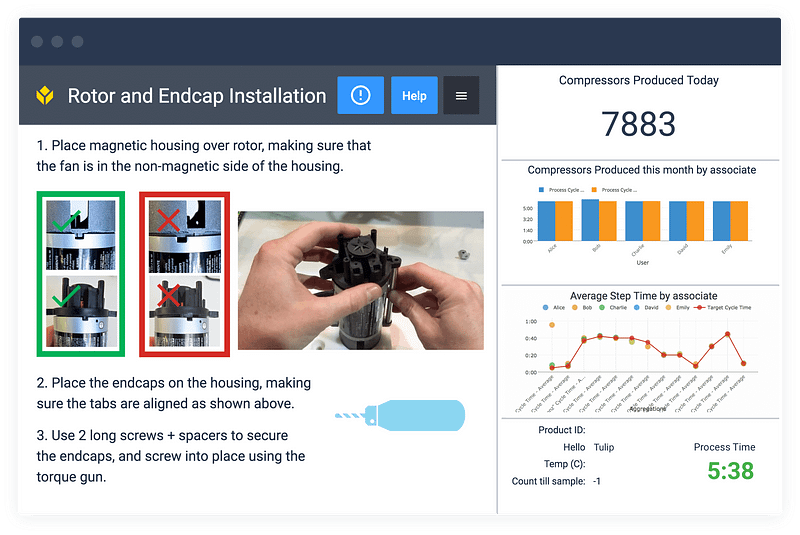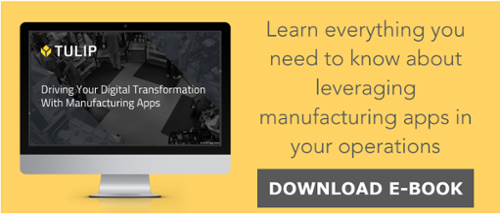
The Manufacturing Industry seems to be taken ablaze with Manufacturing Apps — you can’t seem to strike a conversation with manufacturing thought leaders, industry analysts or attend industry events without talking about their potential.
Being pioneers of this technology, at Tulip we’re ecstatic to see this. However, we’re getting to the point were Manufacturing Apps means different things to different people.
So, what ARE manufacturing apps? Here is one way we like to define them:
“Manufacturing Apps turn industrial workflows into instrumented, data collecting, digital processes that integrate operator, machine, and sensor data to achieve business goals.”
Yes, we know, that’s a mouthful. The best way to understand the definition is to compare how you would do things before and after using Manufacturing Apps. Some examples are:
Before — Process Engineers use a clipboard and stopwatch to measure an operator’s performance. An individual’s data isn’t accessible beyond a couple of days, unless the process engineer types it on a spreadsheet that is easily accessible by everyone. The process is time-consuming, and the data is always lagging behind the operations.
After — With Manufacturing Apps, every step on your workflows generates data that is captured as defined by those closest to your operations. Process and Quality engineers can use the data to improve workflows, line supervisors can use the data to provide targeted feedback to operators, and upper management can use the data to have a real-time picture of the shop-floor.
Before — Operators use paper-based work instructions. These instructions are not easy to follow, delay the operator’s work and don’t help them improve their performance. Furthermore, keeping track of different versions and finding the most recent one is usually a challenge. This leads to the low use of work instructions which in turn leads to higher defect rates.
After — Operators use Manufacturing Apps to create interactive work instructions. These instructions are digital and connect with the tools operators use on their assembly process. These guided assembly apps help operators do a better job, be more productive and make fewer mistakes, so they use them constantly and happily. Operators can provide feedback and improvement ideas for the instructions in real time, and the app can be instantly updated to turn tribal knowledge into standard operating procedure.
Before — You have different data silos for data from machines, operators, sensors and other systems. Some of the data lives in paper; other resides in excel, SQL databases or some third party system. Most data isn’t captured or gets lost. Having a clear, real-time picture of what is going on is challenging, if not impossible.
After — You can integrate all your data sources into a single, holistic view of your process, production line or factory in real-time. The data can be easily analyzed and visualized through an analytics engine and ‘dashboarding’ capability. Furthermore, it can easily be shared with all stakeholders as needed.
Before — Training buddies train new hires and hand hold them for a period during which you have no real visibility on their progress. Every time a new product or process is introduced, you have to re-train everyone, which slows things down. Keeping track of which person has done which training or which person has a particular skill is challenging.
After — You can create Training Manufacturing Apps for new hires to train themselves. You can see their progress as they work through the training apps and have visibility on their skills. When you introduce new process, tools or products to the assembly line, you can deploy new training modules and have operators continue learning on the job.
Before — You have legacy machines and perhaps some newer more advanced ones, but they can’t talk with you or each other quickly. Clunky interfaces make them prone to mistakes. Someone has to check the machines regularly to see if they are working. The changeover and startup process is ripe with human errors.
After — You can connect your machines to your Apps and make them interact with each other. You can calculate OEE as best suits your business needs, automatically and in real time. You can build manufacturing apps to act as an interface for legacy machines and create apps to help your team perform changeover and maintenance more efficiently. Furthermore, you can leverage the Industrial IoT by connecting your tools, sensors and machines to your apps.
These are but a few examples of all the ways in which Manufacturing Apps change the way manufacturing is run. Hopefully, you now have a better sense of what Manufacturing Apps are and how they can change the way you run your operations.
Using Tulip’s Manufacturing App Platform, you can build these apps yourself through a drag and drop, visual programming interface. This means you don’t need to know how to code or rely on third parties to develop the apps for you!
On a next post, we’ll dive into specific use cases and their impact on the bottom-line. Stay Tuned.
